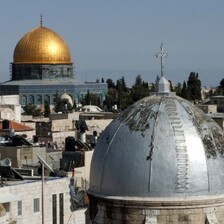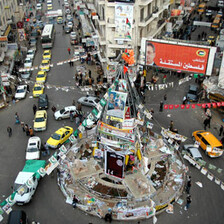The Electronic Intifada 20 June 2007

Hamas supporters at a rally in Gaza City hold a portrait of deposed prime minister, Ismail Haniyeh, 15 June 2007. (Wissam Nassar/MaanImages)
The recent overrunning of Gaza by Hamas militants was the equivalent to the United States’ Shock and Awe campaign in Iraq. Both campaigns were conducted outside the realm of international law and were violent and brutal, albeit each relative to their respective resources and internal contexts; both claimed to be “preemptive” in nature; and both events placed the Palestinian people and struggle for national liberation in even a more precarious position.
Shock and Awe is a US invention in the same way that the US flavor of “shrink wrapped” democracy is a US creation. As the Bush Administration failed to export its understanding of democracy to Iraq via the US military, the US’s second regional blunder was trying to impose US democracy in occupied Palestine by using a proxy governing body called the Palestinian Authority. The US’s weapon of choice for Palestine was to dangle millions of dollars as bait, there for the taking if the Palestinian leadership showed total obedience. While US and other donor countries channeled billions of dollars to ‘promote’ democracy and ‘build’ Palestinian security forces, Hamas was busy learning the intricacies of the US game of military shock and awe and imposed democracy. During the last 17 months, Hamas attempted both, successfully: they won democratically held elections, as confirmed by election observer President Jimmy Carter, and then went on to overrun Gaza by brute force.
One thing Hamas did not do during this short time was govern. Correctly blaming their inability to govern on the Israeli and US-led economic blockade and the blatantly illegal Israeli policy of arresting Hamas-affiliated ministers and lawmakers, Hamas was given a free ride — permitted to sit in the seat of authority without having to assume the full responsibility of governance. Instead of respecting the outcome of elections that one if its own past presidents monitored, the US allowed the Palestinian people to remain unable to define Hamas either as a legitimate governing body or as a failed experience. US meddling in other peoples internal affairs is the norm in the Middle East, but in Palestine, that norm was violently challenged last week in Gaza.
While Palestinian President Yasser Arafat was still alive, the US initiated the process of restructuring the Palestinian political system. The US forced Arafat to accept the creation of the position of prime minister, then they proceeded to demand that the bulk of the Palestinian president’s authority be transferred from President Arafat to the newly appointed prime minister. Then the US created a series of political hoops that Arafat would have to jump through to remain in the political game, of which the most relevant given today’s crisis was the restructuring of the Palestinian security forces. Millions of dollars and tons of equipment were dumped on the multitude of Palestinian security agencies and a high-profile US security ‘expert,’ U.S. Lieutenant General Keith Dayton, set up shop in Israel to make sure the Palestinian security forces were developing strategically, those same security agencies that were overrun in Gaza in a matter of hours. Then, Palestinians, under extreme pressure from the US, held legislative and municipal elections and when the results were not to the US’s liking, the Bush Administration mobilized the world to boycott the Palestinians — people and government alike.
While all of this was going on, Israel maintained its hypocritical posture of the past 10 years — talking peace while at the same time destroying any chances for a peaceful settlement. In the hopeful days of the Oslo Peace Accords, Israel accelerated its illegal Jewish-only settlement-building in the West Bank like never before. When a Jewish extremist assassinated Israeli Prime Minister Yitzhak Rabin, the Oslo framework was, for all intents and purposes, buried with him. To make sure the central Oslo principle of “land for peace” would never be resurrected, Israel violently increased its attempts to bring about the collapse of Palestinian society via “targeted” assassinations, home demolitions, uprooting of olive tree groves, over 500 military checkpoints, withholding $800 million in Palestinian tax revenues, nightly arrests, building of an internationally-condemned illegal separation wall on Palestinian lands, and on and on. This is the true context leading to the violence in Gaza. All of this — and the international community watched, while continuing to fund the status quo and, all the while, referencing Israeli obligations in the already buried Oslo Peace Accords.
Thus, today’s events did not drop out of the sky unexpectedly. A four-part mixture of 40 years of Israeli occupation, a US-led coup to collapse a democratically elected Palestinian government, a shift in internal Palestinian power-sharing after over 40 years of a single-party monopoly on authority, and most importantly, the international community’s failure to uphold its obligations under international humanitarian law — the Fourth Geneva Convention to be specific: All contributed to bringing us to where we are today.
The international community has a clear decision to make, and the decision must be made now. Will the community of nations bring about an abrupt end to the four-decade-old Israeli occupation that has caused so much death and destruction to both Palestinians and Israelis? To end the occupation today would mean to do the near impossible task of salvaging a sovereign Palestinian state on all of the land that was acquired by force by Israel in 1967. Barring this, the international community will likely continue to appease the Israeli occupiers, thereby forcing the Palestinians to revert back to calling for possibly the only remaining viable solution, the formal creation of one state from the Mediterranean Sea to the Jordan River for all its citizens.
Given the Israeli refusal, even today, to classify the Gaza Strip and West Bank, including East Jerusalem, as “occupied lands” and the refusal to mark the Green Line (1949 Armistice Line) in most of the textbooks in their schools, all indications are that the Israelis have already decided that there is no room, on the ground, for another state between Israel and Jordan, although in cheap verbal discourse one may be led to believe that such a state already exists and that its citizens are squabbling over ministerial positions.
The US and Israel, drunk on power and addicted to war, have enlisted many in the region to do their dirty work. As the US and Israel try to distance themselves from their many colossal failures — from Iraq to Palestine — by engineering the creation of banana republics to serve their narrow self-interests, millions of common folk fall deeper into poverty and extremism.
Palestinians may be at a low point in their history and corrective action is undoubtedly on the horizon. The Palestinian people have a collective memory like that of an elephant, and as such the rampage and killings in Gaza by fellow Palestinians will not be legitimized or swept under the rug. Most likely, Hamas’ brutal actions in Gaza will mark the beginning of the end of Hamas as we know it today. With Hamas in the picture, or otherwise, the Palestinians will maintain a pluralistic society and political system that will continue to resist, as has been the case since the outset of this struggle, all foreign intervention in its internal affairs, be it Western, Iranian or Arab.
The present is volatile and the future is bleak, but one thing remains constant: When all the dust settles, there will still be an occupied and dispersed people — the Palestinians — and a colonial, military occupier — Israel. No Shock and Awe campaign, from Hamas or Israel, and no imposed democracy, from Fatah or the US, will change this equation. Until Palestinians are free — all Palestinians — the world would be well advised, for all our sakes, not to turn its back on our just struggle.
Sam Bahour is a Palestinian-American living in El-Bireh/Ramallah and may be reached at sbahour AT palnet DOT com.
Related Links





